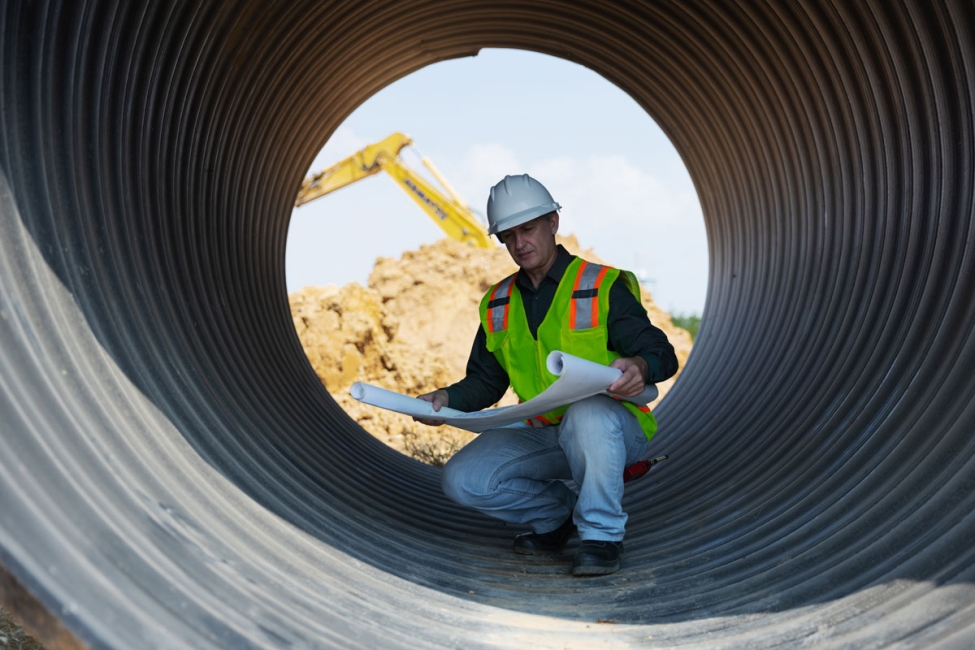
Culverts are enclosed conduits that carry surface water beneath roads, railways, trails, and embankments, allowing drainage and traffic to coexist safely. They form one of the most common, and often most overlooked, structures in municipal stormwater networks. When sized, installed, and maintained correctly, they efficiently convey peak flows, minimize roadway overtopping, protect embankment integrity, and preserve natural drainage patterns.
Culverts fall into three broad shapes, circular pipes, rectangular boxes, and arched or elliptical profiles. Circular pipe culverts remain popular for their hydraulic efficiency, structural strength, and straightforward installation. Box culverts, cast in situ or precast, offer greater flow area at lower heights and are favored where headroom is limited or where wildlife passage is important. Arch and ellipse shapes provide a compromise, maximizing natural channel width while reducing excavation.
Common materials include reinforced concrete, corrugated metal, high-density polyethylene, and fiberglass‐reinforced polymer. Concrete delivers long service life and high load capacity, though joints must remain watertight to prevent bedding erosion. Corrugated metal is lightweight and easy to handle, yet susceptible to corrosion unless coated or polymer-lined. Plastic options resist corrosion and abrasion, accommodate modest deflection, and are quick to lay, but they require proper bedding and cover to avoid deformation. Material selection should balance upfront cost, expected service life, hydraulic roughness, soil chemistry, and load demands.
Hydraulic sizing centers on design storm recurrence intervals established by local standards, available head, permissible backwater, and tailwater conditions. Engineers compare inlet control, governed by the entrance geometry, with outlet control, influenced by barrel friction and downstream water level. The governing mode sets the diameter or span. Roadway overtopping frequency dictates freeboard requirements, while inlet flares, headwalls, and wingwalls can improve capacity and reduce scour.
Structurally, culverts must withstand soil overburden, traffic loads, and hydrostatic pressures. Rigid culverts, such as concrete boxes, carry loads primarily through their own strength, whereas flexible culverts, such as corrugated metal pipes, rely on soil‐structure interaction. Proper bedding compaction, envelope backfill, and cover depth are critical to load distribution and long-term performance.

Successful installation begins with a stable excavation and a well-graded bedding layer that supports the invert uniformly. Sections should be aligned on grade, joints sealed, and backfill placed in lifts no thicker than one foot, compacted to the specified density. For plastic pipes, controlled low-strength material may be used to guarantee uniform support and mitigate floatation in high groundwater. A properly formed inlet apron and an outlet protection apron, often riprap or articulated block, reduce entrance losses and resist downstream scour.
Routine inspection keeps culverts functional over their design life. Crews should look for sediment buildup, debris accumulation, joint separation, pipe deformation, corrosion, and inlet or outlet erosion. Vegetation management at the inlet prevents blockages, while periodic flushing or vacuum removal restores flow area. Small defects discovered early, such as isolated corrosion cells or hairline cracks, can be repaired with patch liners or epoxy injections, extending life at modest cost.
When deterioration progresses beyond minor repair, municipalities can choose between trenchless lining and full replacement. Slip lining, cured-in-place pipe, or spiral wound liners restore structural integrity and hydraulic capacity without disturbing the roadway, making them attractive where traffic disruption must be minimized. Full replacement, though more expensive and disruptive, may be necessary if the culvert is under-sized, badly distorted, or causing recurrent flooding. Coordinating replacement with roadway resurfacing or utility work reduces overall life-cycle cost.
Culverts intersect regulatory requirements under MS4 permits, floodplain ordinances, and, in many regions, fish and wildlife passage rules. Improperly set inverts can create perched outlets that block aquatic species. Oversized or embedded culverts mimic the natural stream bed and maintain ecological connectivity. Where total maximum daily load (TMDL) limits apply, retrofitting energy dissipation basins or sediment forebays at outlets helps meet water quality objectives.
Culverts may seem mundane, yet their performance influences roadway safety, flood resilience, and ecosystem health. A disciplined approach to design, material selection, installation, and maintenance ensures these unseen structures quietly serve the municipality for decades. When municipalities catalogue stormwater components, culverts should rank high in both capital planning and routine inspection schedules, reflecting their critical role in conveying runoff and protecting public infrastructure.
 Wetlands are often described as the kidneys of the watershed because they filter, slow, and transform the water that passes through them in ways that …
Wetlands are often described as the kidneys of the watershed because they filter, slow, and transform the water that passes through them in ways that …
 Field inspections of catch basins, manholes, culverts, and outfalls form the foundation of responsible stormwater management. These routine checks giv…
Field inspections of catch basins, manholes, culverts, and outfalls form the foundation of responsible stormwater management. These routine checks giv…
 Habitat disruption around drainage structures is often subtle at first, and many of the earliest signs tend to appear during ordinary field work rathe…
Habitat disruption around drainage structures is often subtle at first, and many of the earliest signs tend to appear during ordinary field work rathe…
 Harmful algal blooms have become one of the most pressing water quality problems in many regions, and their rise has been linked to a complicated blen…
Harmful algal blooms have become one of the most pressing water quality problems in many regions, and their rise has been linked to a complicated blen…
 The Salton Sea is one of California’s most unusual and tragic landscapes, a place shaped by accident, transformed by ambition, and ultimately pu…
The Salton Sea is one of California’s most unusual and tragic landscapes, a place shaped by accident, transformed by ambition, and ultimately pu…
 *The screenshots used in this article are from Roadwurx, an asset management software created for road maintenance departments. Managing a town’…
*The screenshots used in this article are from Roadwurx, an asset management software created for road maintenance departments. Managing a town’…